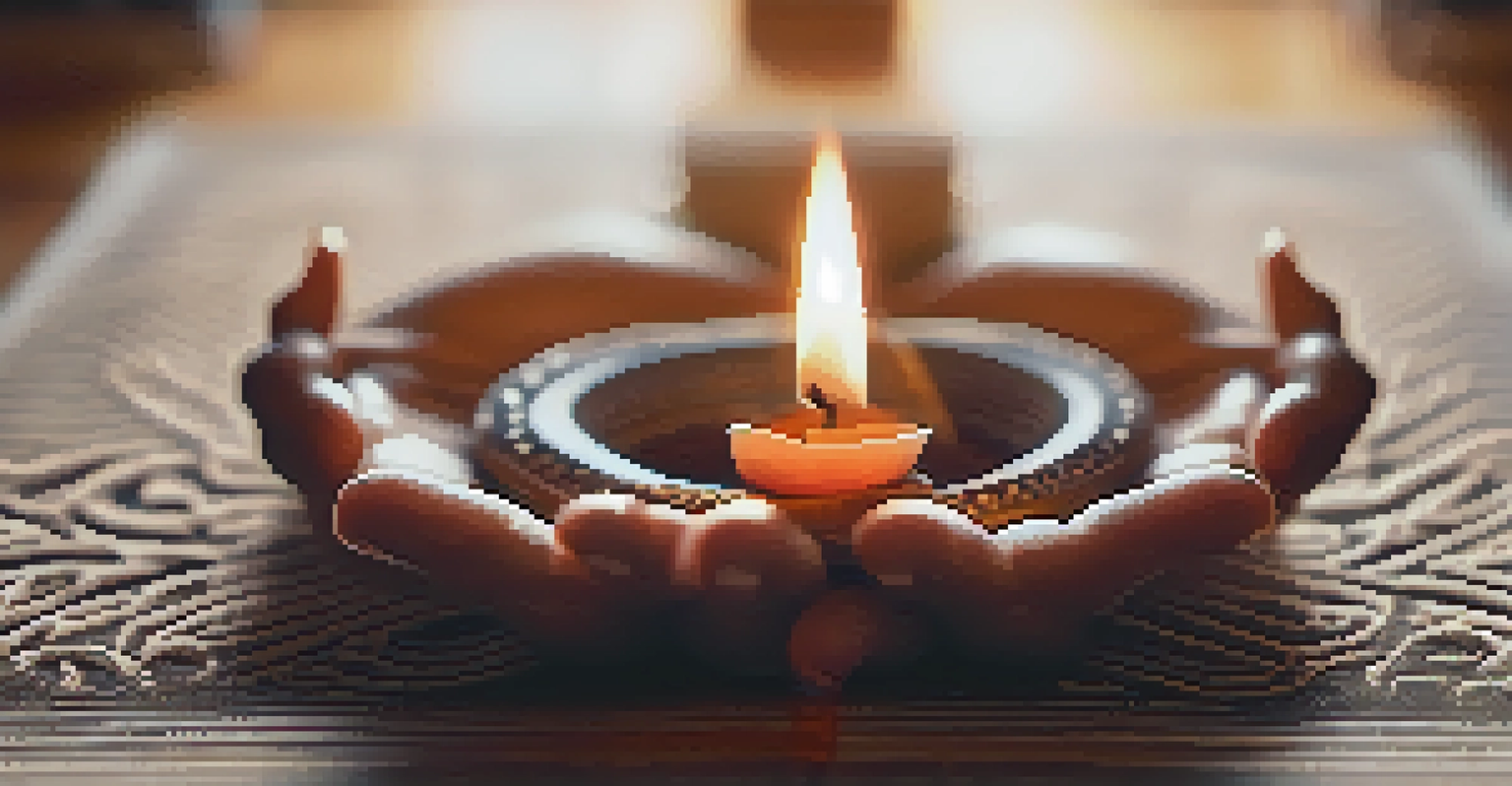Understanding Yoga's Roots: A Journey Through Its History

The Ancient Beginnings of Yoga: A Spiritual Foundation
Yoga has deep roots that trace back over 5,000 years in ancient India. It began as a spiritual practice aimed at achieving harmony between the mind, body, and spirit. This early form of yoga was closely linked to meditation and philosophical teachings found in texts like the Vedas.
Yoga is not just a workout; it's a work-in.
As practitioners sought to delve deeper into the nature of existence, yoga evolved into a discipline that included physical postures, breathing techniques, and meditation. The early yogis viewed these practices as a means to connect with the divine and attain enlightenment.
In essence, the origins of yoga were not merely about physical fitness but about spiritual awakening and understanding one's true self. This foundational aspect continues to resonate in various forms of yoga practiced today.
The Influence of Hinduism and Buddhism on Yoga
As yoga developed, it became intertwined with major religious traditions like Hinduism and Buddhism. Both faiths contributed significantly to the philosophical and practical dimensions of yoga, shaping its practices and principles. For example, the concept of 'dharma' in Hinduism emphasizes righteous living, which aligns with the ethical guidelines in yoga.

Buddhism introduced mindfulness and meditative techniques that further enriched yoga’s practice. The integration of meditation, which focuses on awareness and mental clarity, transformed yoga into a holistic approach to wellness.
Influence of Religion on Yoga
Hinduism and Buddhism significantly shaped yoga's philosophy and practices, introducing concepts like 'dharma' and mindfulness.
Thus, the fusion of these religious philosophies not only broadened yoga's appeal but also deepened its purpose, allowing practitioners to explore spirituality alongside physical health.
The Compilation of Classical Texts: Yoga Sutras and More
One of the pivotal moments in yoga's history was the compilation of classical texts such as the 'Yoga Sutras' by Patanjali around the 2nd century BCE. This seminal work outlined the philosophy of yoga and introduced the eight limbs of yoga, providing a comprehensive framework for practitioners.
The practice of yoga brings us face to face with the extraordinary complexity of our own being.
The Yoga Sutras emphasize the importance of discipline, meditation, and ethical conduct, presenting a path to personal development and enlightenment. These teachings helped to formalize yoga as a structured practice rather than a collection of disparate techniques.
Through these texts, yoga was codified and began to spread beyond its geographical origins, influencing countless generations and laying the groundwork for modern practices.
The Rise of Hatha Yoga: Bridging Body and Mind
Hatha yoga emerged as a significant branch of yoga, focusing on physical postures (asanas) and breath control (pranayama). Its practices were designed to prepare the body for meditation, making it easier for practitioners to achieve mental clarity.
The introduction of Hatha yoga in the medieval period marked a shift towards more physically demanding practices, appealing to a wider audience. It emphasized the connection between the body and mind, promoting overall health and wellness.
Yoga's Spiritual Foundations
Yoga originated over 5,000 years ago in ancient India as a spiritual practice aimed at achieving harmony between the mind, body, and spirit.
As Hatha yoga gained popularity, it opened the door for other styles and interpretations, showcasing the adaptability of yoga to meet the needs of various practitioners.
Yoga in the Modern Era: Globalization and Adaptation
The 20th century brought about a significant transformation in how yoga was perceived and practiced worldwide. Influential teachers such as B.K.S. Iyengar and Pattabhi Jois introduced yoga to the West, adapting traditional practices to suit modern lifestyles.
This globalization of yoga led to the emergence of various styles, including Vinyasa, Ashtanga, and Power Yoga, each catering to different preferences and fitness levels. The focus shifted towards physicality, often overshadowing the spiritual roots of yoga.
Despite these changes, many practitioners still seek to honor yoga's original teachings, blending the physical and spiritual aspects to create a balanced practice.
The Role of Yoga in Contemporary Wellness Culture
Today, yoga is more than just a physical exercise; it has become a cornerstone of holistic wellness culture. Many people turn to yoga for stress relief, mental clarity, and physical fitness, integrating it into their daily routines.
Yoga studios and wellness centers have proliferated, offering classes that emphasize not only the physical postures but also mindfulness, breathing techniques, and meditation. This comprehensive approach appeals to those seeking a healthier lifestyle.
Yoga's Spiritual and Historical Roots
Yoga originated over 5,000 years ago in ancient India as a spiritual practice aimed at achieving harmony between mind, body, and spirit.
Moreover, the practice of yoga has been studied for its benefits on mental health, leading to increased acceptance and incorporation into therapeutic settings. This evolution highlights yoga's enduring relevance in today’s fast-paced world.
Preserving Yoga's Authenticity in Modern Practice
As yoga continues to evolve, there is an ongoing conversation about preserving its authenticity. With the commercialization of yoga, some practitioners express concern that core teachings and philosophies are being diluted.
Many advocates emphasize the importance of understanding yoga's roots and honoring its rich history. This includes studying classical texts and practicing with awareness of the spiritual dimensions that originally inspired yoga.

By doing so, practitioners can enjoy the physical benefits of yoga while also nurturing their inner journey, ensuring that the practice remains true to its roots.